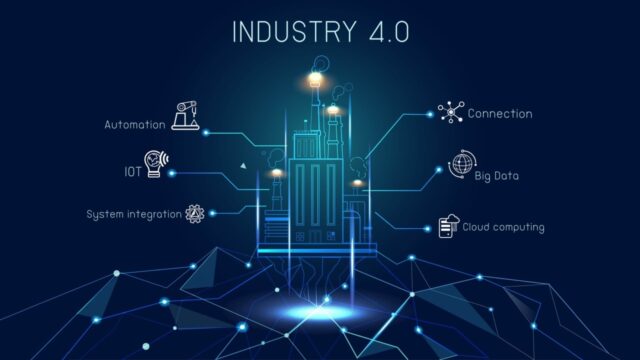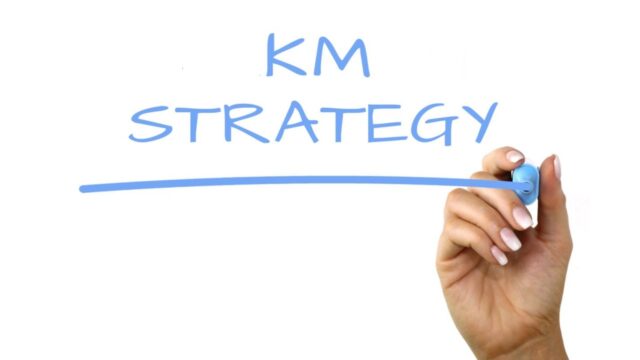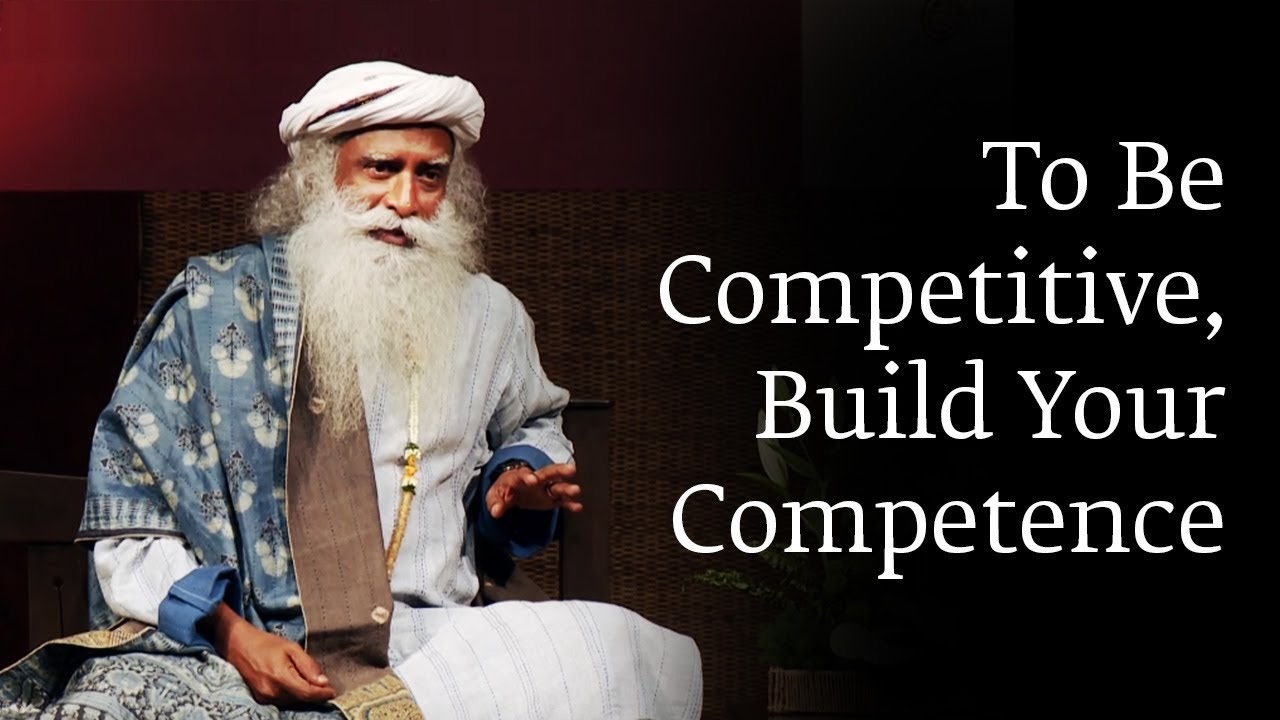
How to make yourself a COMPETITIVE knowledge manager in the library and information field
This article will focus on three key phrases: KNOWLEDGE MANAGER, BE COMPETITIVE, LIBRARY AND INFORMATION FIELD to discuss three issues. First, what is the role of knowledge manager in this new era? Second, how to be a competitive knowledge manager? Third, looking specifically at the library and information sector, how to be a competitive knowledge management manager in this field? If you agree or disagree, you’re welcome to comment below!
The role of knowledge manager in the age of big data
When I was just learning about knowledge management, I went into a misunderstanding, always obsessing about how to get data more quickly and how to process information better. I thought that only when the information is processed well can it be transformed into knowledge. But in fact, the focus of knowledge management is not on how information can be transformed into knowledge, but on how to use knowledge to better help us make decisions when we encounter problems.
Giving value to data through becoming information is a qualified data analyst’s task, but we need knowledge to help us make effective decisions; this is tricky, requiring a knowledge manager to give value to information to become the needed knowledge (Figure 1). In the era of big data, there are huge amounts of data and information, and there are countless excellent data analysts. However, in many enterprises in China, they do not have the position of knowledge manager, which means things stop at the process of giving value to data and processing it into information. Therefore, no matter how well the information is handled, it is difficult to effectively convert the processed information into knowledge, which can’t assist enterprises to make knowledge-based decisions, just more data-based decisions at present. Chinese universities also seldom offer knowledge management related majors.
Therefore, in the era of big data, as knowledge managers, we have to clearly distinguish between knowledge-based decisions and data-based decisions. By analyzing and interpreting the processed information, we have to become a facilitator to help enterprises to innovate and create value, to identify market opportunities and trends for enterprises, and to make knowledge-based decisions.
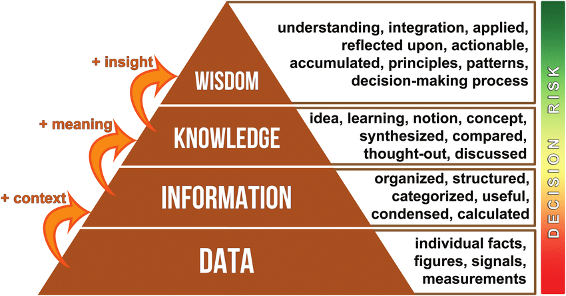
How to be a competitive knowledge manager
A competitive knowledge manager can be divided into two aspects in knowledge management: internal management and external management. Internal management is the knowledge management within the company, which promotes the communication and collaboration between departments and teams, and facilitates the mutual conversion of tacit knowledge and explicit knowledge. External management is to identify potential opportunities and dangers in the market by analyzing the company’s internal capabilities and external environment, and to help the company make short-term decisions and long-term strategic planning.
In internal management, the SECI model2 can be customized by different enterprise types. The original SECI model (Figure 1) is socialization, externalization, combination, and internalization. These four processes describe the cyclic process of knowledge transformation from tacit to explicit, and then from explicit to tacit, which is a dynamic pattern of knowledge creation and sharing.
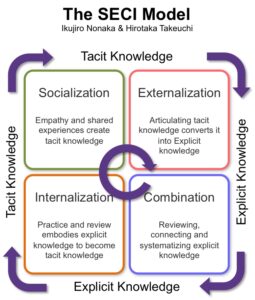
When facing different types of enterprises, knowledge manager should not be limited to the traditional SECI model for internal management, but should modify this model according to the actual situation of the enterprise. For example, in a software company, the process of software development is complex, and knowledge is fragmented. Tacit knowledge in software development is acquired according to experience, and the experience of every programmer is different, so it is very difficult to spread tacit knowledge in software companies. Therefore, Tizkar Sadabadi & Abdul Manaf modified the SECI model3 for software companies to change externalization to accumulation (Figure 3). This emphasized reflection on personal experiences rather than sharing. It mainly separates individuals and organizations, emphasizing the importance of individual learning and knowledge dissemination. This separation helps simplify the complexity associated with organizational learning, and is very suitable for application in complex software project management. Therefore, when dealing with different types of enterprises, the most suitable model should be developed for management according to the actual situation.
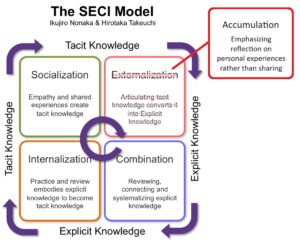
In external management, the first step should be to ensure that knowledge is effectively captured, stored, shared and applied. Secondly, we must have foresight and always capture market information and development trends. Finally, it is necessary to integrate the latest technology to make the process of knowledge support decision-making more productive, efficient, and effective. For example, establishing a powerful knowledge management system helps enterprises to capture, store, share and apply knowledge. At the same time, AI technology can be used to analyze the behavioral preferences of different users in the system, and recommend relevant knowledge to them. This is conducive to reducing user search time, but also can improve user learning efficiency.
Through the release of Apple Vision Pro (Figure 4), I also see the prospect of combining the development of VR and knowledge management. VR provides an immersive environment that can help employees visualize knowledge through immersive learning and training. It can also help companies to simulate complex scenarios and conduct simulation tests before implementing decisions, which is conducive to risk avoidance.

Knowledge manager in the library and information field
In addition to helping companies make decisions, knowledge managers have the potential to grow in the special field of library and information. Why is it special? Because the library carries books, books are the carrier of knowledge. Unlike in commercial companies, knowledge managers do not need to use knowledge to support decisions in libraries, but need to disseminate knowledge to customers more effectively. How to spread it?
Nowadays, libraries are more likely to have librarians counting the number of books with the help of the library lending system, which is a traditional way of borrowing books. I think in the future, knowledge manager can realize knowledge fission by establishing knowledge maps and using “QR codes” with books (Figure 5). By scanning the QR code, customers can not only see the electronic version of the book represented by the QR code, but also see other related content extended by the book. For example, I want to borrow the novel Jane Eyre. I go to the library or the library website and scan Jane Eyre’s QR code. My digital screen will show the book Jane Eyre, the movie Jane Eyre, other books by Jane Eyre’s author Charlotte Brontë, Jane Eyre reader reviews, recommendations of books similar to Jane Eyre, and so on. This kind of fission of knowledge not only can spread knowledge to customers more effectively, but also can even achieve no need to return books, not to go to the library, paperless reading, reduce labor costs and promote sustainable development. If combined with VR technology to deepen customer experience, the potential of Knowledge manager in the library and information field is endless.
Therefore, to be a competitive knowledge manager in the library and information field, we need to look for future market gaps and keep thinking and innovating.

Article source: Adapted from How to Make Yourself a COMPETITIVE Knowledge Manager in the field of Library and Information, prepared as part of the requirements for completion of course KM6304 Knowledge Management Strategies and Policies in the Nanyang Technological University Singapore Master of Science in Knowledge Management (KM).

Header image source: Sadhguru, CC BY 4.0.
References:
- Ackoff, R. L. (1989). From Data to Wisdom. Journal of Applied Systems Analysis, 16, 3-9. ↩
- Nonaka, I. (1994). A dynamic theory of organizational knowledge creation. Organization Science, 5(1), 14-37. ↩
- Tizkar Sadabadi, A., & Abdul Manaf, A. (2018). IKML approach to integrating knowledge management and learning for software project management. Knowledge Management Research & Practice, 16(3), 343-355. ↩



